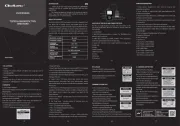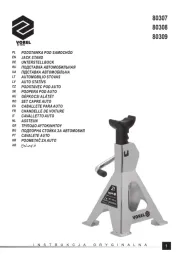Dual C 804 Handleiding
Dual
Niet gecategoriseerd
C 804
Bekijk gratis de handleiding van Dual C 804 (17 pagina’s), behorend tot de categorie Niet gecategoriseerd. Deze gids werd als nuttig beoordeeld door 188 mensen en kreeg gemiddeld 4.6 sterren uit 94.5 reviews. Heb je een vraag over Dual C 804 of wil je andere gebruikers van dit product iets vragen? Stel een vraag
Pagina 1/17

Service
-Anleitung
Service
Manual
Instructions
de
Service
0111011
000
SYS1141
---
WUMM
----
11.010
•
Cr
Dual
804
}P
IO
)
5
3.
101
,•
•
R/GMY
INHALT
CONTENTS
SOMMAIRE
2
Blockschaltbild
Bloc
diagram
Schärna
de
bloc
Funktionsbeschreibung
3
Functional
description
Description
du
fonctionnement
4
Abgleichanleitung
Alignment
instructions
Instructions
d'alignement
6
Abgleichpositionen
Alignment
positions
Positions
d'alignement
7
Schaltbild
1Niring
diagram
Schäma
d'älectrique
9
IC-Blockdiagramm
IC
-bloc
diagram
Schäma
de
bloc
IC
10
Grundplatte
Base
plate
Plaque
de
base
11
Verdrahtungsplan
Wiring
schema
Schäma
de
cäble
12
Ersatzteile
mit
Replacement
with
Piöces
dätachäes
et
vues
Explosionsdarstellung
exploded
views
explosäes
16
Technische
Daten
Technical
data
Caractäristiques
techniques
Dual
Gebrüder
Steidinger
GmbH
&
Co.
•
7742
St.
Georgen/Schwarzwald
Download from www.dual.de
Not for commercial use

Blockschaltbild
/
Bloc
diagram
/
Schärna
de
bloc
Plug
DIN
Out/In
4
r.
Mic
In
I
VA
S2
S2
S2
010
i 0 0 0 0 0
RP
Head
E
Head
r.K.
—
/VR
105
Playback
DIN/MIC
Amp.
T101
T102
T
Switch
Bias
Osc.
T
303
A A
VR
101
VR
102
T
lt
S2
S2
Cid
, 0 0 0 0
S2
A
Dolby
circuit
IC
101
Meter
Driver
T
104
T
105
T
106
Recording
Amp.
T
107
Muting
IC
301
I
301
Auto
Stop
IC
302
T
302
Tape
Run
Sensor
Stop
Solenoid
Funktionsbeschreibung
C
804
S2
0 0 0
A
(20
V/
Switch
Plate
Fe
Cr
Met
Dolby
S
2
=
R/P
Switch
(Playback
Position)
Wiedergabe
Die
vom
Tonkopf
kommende
Spannung
(ca.
300
biV
beim
Abspielen
des
DIN
-Bezugspegels)
wird
mit
den
Transistoren
0
101
und
0
102
ver-
stärkt
und
mit
dem
Gegenkopplungsnetzwerk
R
114,
R
115
und
C
106
entsprechend
entzerrt.
Die
Umschaltung
der
Wiedergabeentzerrung
von
120
bis
auf
70
bis
erfolgt
durch
das
Durchschalten
von
0
103.
Der
Wie-
dergabepegel
wird
beim
Abspielen
des
Dolby-Bezugspegels
(200
nWb/m)
mit
VR
102
auf
550
mV,
gemessen
an
dem
DIN
-Ausgangsstecker,
einge-
stellt.
Diese
Einstellung
ist
für
eine
einwandfreie
Funktion
der
Dolby-
schaltung
notwendig.
Das
Wiedergabesignal
gelangt
über
den
A
-W
-Schalter
S
2
—
4
zum
Ein-
gang
der
Dolbyschaltung
IC
101,
Pin
5.
Ist
der
Dolby-Wahlschalter
S
4
ausgeschaltet,
wird
das
Signal
innerhalb
der
Dolbyschaltung
um
ca.
26
db
linear
verstärkt,
während
bei
eingeschaltetem
Dolby
frequenz-
und
pegelabhängig
verstärkt
wird.
Das
Ausgangssignal
gelangt
von
Pin
7
(IC
1011
über
C
119
und
R
126
an
den
Anzeigeverstärker
0
104
und
über
den
A
-W
-Schalter
S
2
—6
an
den
DIN-Stecker.
Aufnahme
Für
die
Aufnahme
stehen
zwei
Quellen
zur
Verfügung.
Bei
Belegung
des
Mikrofoneinganges
wird
der
DIN-Eingang
abgeschaltet.
Das
Eingangssig-
nal
wird
mit
den
Transistoren
Q
101
und
0
102
verstärkt.
Mit
S
2
—3
wird
das
linear
arbeitende
Gegenkopplungsnetzwerk
R
116,
C
107
hin-
zugeschaltet.
Das
verstärkte
Signal
gelangt
an
den
Aussteuerungssteller
VR
101
und
über
den
A
-W
-Schalter
S
2
—
4
an
den
Eingang
Pin
5
der
Dolbyschaltung
IC
102.
Das
Ausgangssignal
von
Pin
7
gelangt
an
den
Anzeigeverstärker
0104
und
überden
A
-W
-Schalter
S
2
—
6
und
VR
104
an
den
Aufnahmeverstärker
Q
107.
Der
Aufsprechstrom
wird
durch
VR
104
beeinflußt,
der
Pegel
und
die
Entzerrung
werden
über
die
Transistoren
Q
105
(Fe)
und
Q
106
(Met)
an
die
unterschiedlichen
Bandsorten
angepaßt.
Die
Cr
Anpassung
erfolgt,
wenn
beide
Transistoren
sperren.
Über
den
Sperrkreis
F
102
wird
das
Aufnahmesignal
dem
Ton-
kopf
zugeführt,
mit
VR
105
wird
die
Vormagnetisierung
dazugemischt.
Durch
Zuschalten
der
Widerstände
R
320
bis
R
322
durch
die
Bandsor-
tenwahlschalter
S
3
—
1
Fe,
S
3
—
2
Cr
und
S
3
—
3
Met,
wird
der
Voltage
stab.
T
304
T
305
B
(13
V)
Rec
LED
Level
Meter
F2
rr
—
n
230
V
T
400
mA
I
F
1
1
S
1
T
63
mA
F3
115V
T
400
mA
Meter
Lamp
HF-Oszillator
so
beeinflußt,
daß
sich
für
die
verschiedenen
Bandsorten
ein
optimaler
Arbeitspunkt
ergibt.
Bei
Aufnahmebetrieb
wird
der
DIN-
Ausgang
mit
A
-W
-Schalter
S
2
—
6
vom
Signalweg
abgeschaltet.
Aussteuerungsanzei
ge
Das
Ausgangssignal
gelangt
bei
Aufnahme
wie
auch
bei
Wiedergabe
zum
Anzeigeverstärker
Q
104.
Mit
VR
103
wird
die
+3
db
Marke
einge-
stel
lt.
Um
die
verringerte
Aussteuerbarkeit
bei
hohen
Frequenzen
zu
berück-
sichtigen,
wird
mit
R
141
und
C
127
eine
Frequenzgangkorrektur
vor-
genommen.
Die
Anhebung
bei
10
kHz
gegenüber
400
Hz
beträgt
ca.
10
db.
Die
Anzeige
erfolgt
mit
einem
Zeigerinstrument
mit
bedämpftem
Rücklauf
(C
1291.
Stummschaltung
Damit
keine
Schaltgeräusche
an
den
Ausgang
gelangen,
wird
das
NF-Sig-
nal
mit
IC
301
stummgeschaltet,
wobei
Pin
9
den
linken
und
Pin
7
den
rechten
Kanal
gegen
Ground
schalten.
Mit
Betätigen
von
Play-Schalter
S
6
wird
Transistor
Q
301
gesperrt,
es
liegt
ein
HIGH
Signal
an
Pin
6,
die
Stummschaltung
wird
verzögert
aufgehoben
(C
307).
Damit
wird
das
Hochlaufen
der
Tonwelle
abgewartet.
Fällt
die
an
Pin
4
anliegende
Spannung
von
HIGH
auf
LOW
(bei
Power
Off)
so
wird
sofort
stumm
-
geschaltet.
Endabschaltung
Die
Information
„Band
läuft"
wird
von
einer
mehrpoligen
Magnetschei-
be,
die
am
Antriebsrad
des
Zählers
befestigt
ist,
an
IC
303
gegeben.
Dieses
IC
wandelt
die
wechselnden
magnetischen
Felder
in
elektrische
Impulse
um.
Diese
Impulse
gelangen
an
Pin
2
von
IC
301.
An
Pin
1
wird
die
Information
PAUSE
von
Schalter
S
7
eingegeben
(LOW
activ)
wenn
Schalter
S
6
PLAY
geschlossen
ist.
Hört
die
Rotation
der
Magnetscheibe
auf,
steht
am
Ausgang
Pin
5
von
IC
302
ein
HIGH
Signal
,
Transistor
Q
302
steuert
durch
und
legt
0
V
an
den
Magnet
STOP,
der
in
Reihe
mit
dem
Motorschalter
S
5
liegt.
Ist
der
Motor
über
Schalter
S
5
einge-
schaltet,
spricht
der
Magnet
an
und
schaltet
das
Laufwerk
ab.
2

Functional
characteristics
C
804
Description
du
fonctionnement
C
804
Playback
The
voltage
from
the
playback
head
(approximately
300
µV
when
playing
back
at
the
DIN
reference
level)
is
amplified
by
transistors
101
and
0
102
and
suitably
equalized
by
the
feedback
net
work
R
114,
R
115
and
C
106.
Reproduction
equalizing
is
switched
over
from
120
bis
to
70
ps
by
switching
through
0
103.
The
reproduction
level
when
playing
back
at
the
Dolby
reference
level
(200
nWb/m)
is
adjusted
with
VR
102
to
550
mV,
measured
at
the
DIN
outlet.
This
adjustment
is
necessary
for
perfect
fünctioning
of
the
Dolby
circuit.
The
playback
signal
passes
via
the
record/playback
switch
S
2
—
4
to
the
input
of
the
Dolby
circuit
IC
101,
pin
5.
If
the
Dolby
selector
switch
S
4
is
switched
off,
the
signal
is
linear
amplified
within
the
Dolby
circuit
by
approximately
26
db,
wheres,
with
Dolby
switched
in,
lt
is
amplified
according
to
frequency
and
level.
The
output
signal
passes
from
pin
7
(IC
101)
via
C
119
and
R
126
to
the
display
ampli-
fier
Q
104
and
via
the
record/playback
switch
S
2
—6
to
the
DIN
plug.
Recording
Two
sources
are
available
for
recording.
If
a
microphone
is
connected,
the
DIN
input
is
cut
out.
The
input
signal
is
amplified
by
transistors
Q
101
and
Q
102.
The
linear
feedback
network
R
116,
C
107
isswitched
in
at
S
2
—
3.
The
amplified
signal
passes
to
the
recording
level
control
VR
101
and
via
the
record/playback
switch
S
2—
4
to
inpunt
pin
5
of
the
IC
102
Dolby
circuit.
The
output
signal
from
pin
7
passes
to
the
display
amplifier
Q
104
and
via
the
record/playback
switch
S
2
—
6
and
VR
104
to
the
recording
amplifier
0
107.
The
recording
current
is
influenced
by
VR
104,
the
level
and
equalization
are
adapted
to
the
various
types
of
tape
by
transistors
Q
105
(Fe)
and
0
106
(Met).
The
unit
is
adapted
to
chrome
tapes
when
both
transistors
are
blocked.
The
recording
signal
is
fed
to
the
playback
head
via
the
rejector
circuit
F
102
and
magnetic
bias
is
mixed
in
by
VR
105.
Switching
resistors
R
320
to
R
322
through
the
tape
selector
switchesS
3—
1
Fe,
S
3
—2
Cr
and
S
3
—3
Met
influences
the
high-frequency
isolator
to
produce
an
optimal
operating
point
for
the
various
types
of
tape.
During
recording,
the
DIN
output
is
cut
off
from
the
signal
path
by
the
record/playback
switch
S
2
—
6.
Level
indicator
For
recording
and
playback,
the
output
signal
passes
to
the
display
amplifier
0
104.
The
+3
db
mark
is
adjusted
at
VR
103.
Frequency
modulation
is
corrected
with
R
141
and
C
127
to
compen-
sate
for
the
reduction
in
control
at
high
frequencies.
Boosting
at
10
kHz
in
relation
to
400
Hz
is
approximately
10
db.
The
display
consists
of
a
pointer
instrument
with
dampened
return
IC
129).
Muting
The
low-frequency
signal
is
muted
by
IC
301
so
that
no
switching
noises
reach
the
output:
pin
9
connects
the
left
channel
and
pin
7
the
right
channel
to
ground.
When
play
switch
S
6
is
operated,
transistor
Q
301
is
blocked,
a
HIGH
signal
is
produced
at
pin
6
and,
after
a
delay,
muting
is
cancelled
(C
307).
Full-speed
running
of
the
capstan
is
then
awaited.
If
the
voltage
at
pin
4
drops
from
HIGH
to
LOW
(Power
Off)
,
muting
is
immediately
activated.
Final
switching
off
The
"tape
running"
information
is
passed
to
IC
303
by
a
multi-pole
magnetic
disc
fastened
to
the
counter
drive
rail
.
This
IC
converts
the
alternating
magnetic
fields
into
electrical
pulses.
These
pulses
pass
to
pin
2
of
IC
301.
At
pin
1
the
PAUSE
Information
from
S
7
is
entered
(LOW
active)
if
PLAY
switch
S
6
is
closed.
If
the
magnetic
disc
stops
rotating,
a
HIGH
signal
is
produced
at
output
pin
5
of
IC
302,
transistor
Q
302
activates
and
lays
0
V
at
the
magnet
STOP
connected
in
series
with
the
motor
switch
S
5.
If
the
motor
is
switched
on
by
switch
S
5,
the
magnet
response
end
switches
off
the
tape
drive.
Reproduction
La
tension
(env.
300/1V
lors
de
la
lecture
du
niveau
de-räfärence
DIN)
provenant
de
la
täte
sonore
est
amplifiäe
ä
l'aide
des
transistors
0
101
et
0
102
et
corrigäe
avec
le
circuit
de
contre-räaction
R
114,
R
115
et
C
106.
La
commutation
de
la
distorsion
de
reproduction
de
120
,t.ts
ä
70
bis
est
obtenue
par
le
couplage
de
Q
103.
Le
niveau
de
reproduction
est
räglä
sur
550
mV
avec
VR
102,
valeur
mesuräe
sur
la
fiche
de
sortie
DIN,
lors
de
la
lecture
du
niveau
de
räfärence
Dolby
1200
nWb/m).Ce
räglage
est
näcessaire
pour
garantir
le
parfait
fonctionnement
du
circuit
Dolby.
Par
le
commutateur
A
-W
S
2
—
4,
le
signal
de
reproduction
parvient
ä
l'enträe
du
circuit Dolby
IC
101
,
pin
5.
Lorsque
le
sälecteur
Dolby
S
4
est
hors
circuit,
le
signal
est
amplifiä
en
linäaire
d'env.
26
db
dans
le
circuit
Dolby
alors
que,
lorsque
le
sälecteur
Dolby
est
en
circuit,
le
si-
gnal
est
amplifiä
en
fonction
de
la
fräquence
et
du
niveau.
De
pin
7
(IC
101),
le
signal
de
sortie
parvient
ä
l'amplificateur
d'affichage
Q
104
en
passant
par
C
119
et
R
126
et
ä
la
fiche
DIN
en
passant
par
le
com-
mutateur
A
-W
S
2
—6.
Enregistrement
Deux
sources
sont
disponibles
pour
l'enregistrement.
L'enträe
DIN
est
mise
hors
circuit
lorsque
l'enträe
microphone
est
occupäe.
Le
signal
d'enträe
est
amplifiä
a
l'aide
des
transistors
Q
101
et
Q
102.
Avec
S
2
—
3,
le
circuit
de
contre-räaction
R
116,
C
107
fonctionnant
en
linäaire
est
ägalement
couplä.
Le
signal
amplifiä
parvient
au
rägulateur
de
modulation
VR
101
et,
par
le
commutateur
A
-W
S
2
—
4,
ä
l'enträe
pin
5
du
circuit
Dolby
IC
102.
Le
signal
de
sortie
de
pin
7
parvient
ä
l'amplificateur
d'affichage
Q
104
et
ä
l'amplificateur
d'enregistrement
O
107
en
passant
par
le
commutateur
A
-W
S
2
—
6
et
VR
104.
Le
courant
de
räponse
est
influencä
par
VR
104;
le
niveau
et
la
distorsion
sont
adaptäs
aux
diffärentes
sortes
de
bandes
par
les
transistors
0
105
(Fe)
et
Q
106
(Met).
L'adaptation
Cr
se
fait
lorsque
los
deux
transistors
bloquent.
Le
signal
d'enregistrement
est
amanä
ä
la
täte
sonore
en
pas-
sant
par
le
circuit
de
blocage
F
102;
la
prämagnätisation
y
est
mixe
avec
VR
105.
Par
le
couplage
des
räsistances
R
320
ä
R
322
par
les
sälecteurs
de
bande
S
3
—
1
Fe,
S
3
—2
Cr
et
S3
—3
Met,
l'oscillateur
HF
est
influencä
de
facon
ä
ce
qu'un
point
de
travail
optimal
soit
ob-
tenu
pour
les
diffärentes
sortes
de
bandes.
Lors
de
l'enregistrement,
la
sortie
DIN
est
mise
hors
circuit
du
trajet
du
signal
avec
le
commutateur
A
-W
S
2
—
6.
Affichage
de
modulation
Lors
de
l'enregistrement,
tout
comme
pour
la
reproduction,
le
signal
de
sortie
parvient
ä
l'amplificateur
d'affichage
Q
104.
Le
rep'ere
+3
db
est
räglä
avec
VR
103.
Afin
de
tenir
compte
de
l'aptitude
ä
la
modulation
räduite
ä
des
fre-
quences
äleväes,
une
correction
de
la
räponse
en
fräquence
est
effectuäe
avec
R
141
et
C
127.
L'augmentation
de
400
Hz
ä
10
KHz
s'äreve
ä
env.
10
db.
L'affichage
est
effectuä
ä
l'aide
d'un
Instrument
ä
aiguille
ä
retour
amorti
(C
129).
Commutation
silencieuse
Afin
qu'aucun
bruit
de
commutation
ne
parvienne
ä
la
sortie,
le
signal
BF
est
commutä
silencieusement
avec
IC
301,
pin
9
commutant
le
canal
de
gauche
et
pin
7
le
canal
de
droite
contre
le
bruit.
En
actionnant
le
commutateur
PLAY
S6.
le
transistor
0301
bloque,
un
signal
HIGH
est
disponible
sur
pin
6;
la
commutation
silencieuse
est
supprimäe
ä
retarde-
ment
(C
307).
Le
fonctionnement
ä
pleine
puissance
du
cabestan
est
ainsi
attendu.
Lorsque
la
tension
disponible
sur
pin
4
passe
de
HIGH
ä
LOW
(pour
power
OFF)
,
la
commutation
silencieuse
se
fait
immädiate-
ment.
D6clenchement
en
f
in
de
course
L'information
"bande
däfile"
est
transmise
ä
IC
303
par
un
disque
mag-
nätique
multipolaire
fix
ä
sur
la
roue
d'entratnement
du
compteur.
Ce
IC
convertit
les
champs
magnätiques
alternants
en
impulsions
älectriques.
Ces
impulsions
parviennent
ä
pin
2
de
IC
301.
Sur
pin
1,
l'information
PAUSE
est
introduite
par
le
commutateur
S
7
(LOW
activ)
lorsque
le
commutateur
S
6
PLAY
(Lecture)
est
fermä.
Lorsque
la
rotation
du
disque
magnätique
s'arräte,
un
signal
HIGH
est
disponible
sur
la
sortie
pin
5
de
IC
302,
le
transistor
Q
302
est
excitä
et
applique
0
V
sur
l'ai-
mant
STOP
montä
en
särie
avec
l'interrupteur
de
dämarrage
S
5.
Lors-
que
le
moteur
est
mis
en
circuit
par
l'intermädiaire
de
l'interrupteur
S5,
Velment
räpond
et
met
le
mäcanisme
d'entrainement
hors
service.
3
Product specificaties
| Merk: | Dual |
| Categorie: | Niet gecategoriseerd |
| Model: | C 804 |
Heb je hulp nodig?
Als je hulp nodig hebt met Dual C 804 stel dan hieronder een vraag en andere gebruikers zullen je antwoorden
Handleiding Niet gecategoriseerd Dual

30 Januari 2025

30 Januari 2025

30 Januari 2025

30 Januari 2025

8 November 2024

7 November 2024

7 November 2024

7 November 2024

7 November 2024

7 November 2024
Handleiding Niet gecategoriseerd
Nieuwste handleidingen voor Niet gecategoriseerd

13 September 2025

13 September 2025

13 September 2025

13 September 2025

13 September 2025

13 September 2025

13 September 2025

13 September 2025

13 September 2025

13 September 2025